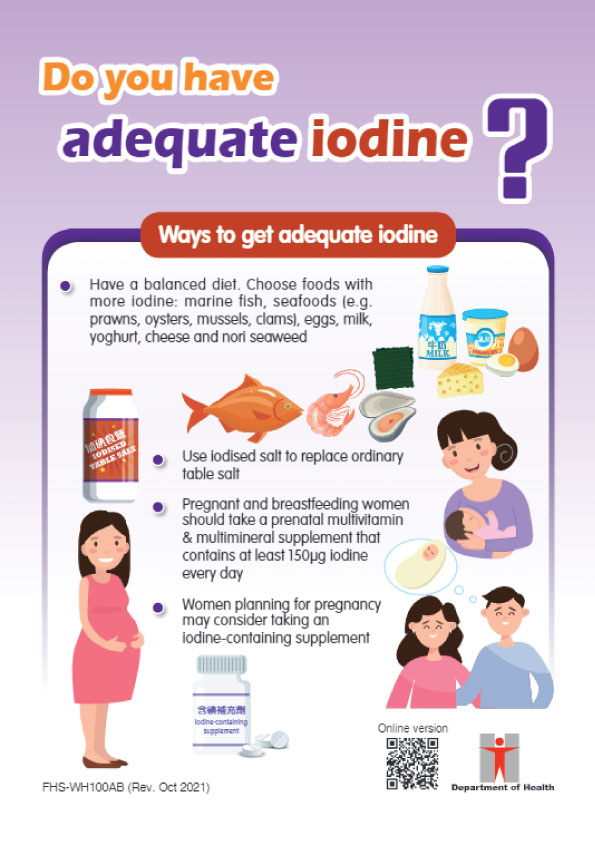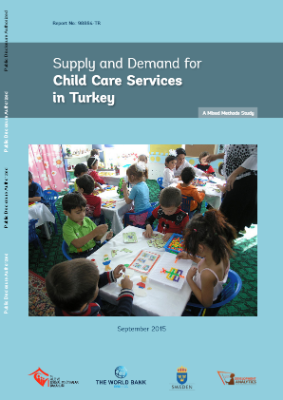Ways to get adequate iodine
- Have a balanced diet. Choose foods with more iodine: marine fish, seafoods (e.g.prawns, oysters, mussels, clams), eggs, milk, yoghurt, cheese and nori seaweed
- Use iodised salt to replace ordinary table salt
- Pregnant and breastfeeding women should take a prenatal multivitamin & multimineral supplement that contains at least 150 µg iodine every day
- Women planning for pregnancy may consider taking an iodine-containing supplement
What is the function of iodine in the body?
- Iodine is an essential nutrient. It is important for thyroxine production in the body.
- Thyroxine affects almost all body systems and is important in cardiovascular and digestive function, metabolism, growth and development, etc. Adequate iodine intake is essential to maintain normal thyroxine level, so that we can grow and develop normally, and stay healthy.
- The development of our nervous system relies on thyroxine. Therefore, it is important to ensure an adequate iodine intake during pregnancy, breastfeeding, infancy and childhood.
What happens when we do not have enough iodine?
- When the body does not have enough iodine, the thyroid gland needs to work harder to maintain adequate thyroxine level. It may become swollen (known as“goitre”). If low iodine intake persists, thyroxine secretion becomes inadequate.
This could lead to hypothyroidism. Symptoms of hypothyroidism include slow response, obesity, menstrual disorders, miscarriage, infertility, etc. - Low iodine intake in pregnant and breastfeeding women could impair brain development in fetuses and infants. In severe cases, this could affect the intelligence of children.
How much iodine do we need daily?
- The iodine requirement differs at different ages and life stages. Pregnant and breastfeeding women have a higher demand for iodine to supply to fetuses and infants.
- The body cannot store a large quantity of iodine. Therefore, we need to take a small amount of iodine regularly. If taken in a large quantity, iodine will be excreted in urine.
- However, taking too much iodine for a prolonged period could affect the thyroid function. Generally speaking, the daily iodine intake of an adult should not exceed 600 micrograms (μg)1
Daily iodine intake recommended by World Health Organization (WHO)
- Preschool children (0 to 59 months)
Daily iodine intake: 90 μg - School children (6 to 12 years)
Daily iodine intake: 120 μg - Adolescents (above 12 years) and adults
Daily iodine intake: 150 μg - Pregnant and lactating women
Daily iodine intake: 250 μg
Iodine intake among Hong Kong adults
- The Centre for Food Safety reported in 2011 that Hong Kong adults had a possible risk of an inadequate iodine intake from diet.
- The Iodine Survey conducted in 2019 showed that iodine intake of the pregnant women who did not take an iodine supplement was “insufficient”. The pregnant women who had an average iodine daily intake of 150 μg from supplement(s), their iodine intake was “adequate”. The iodine intake of lactating mothers was “insufficient” 2.
1 The Chinese Dietary Reference Intakes, Chinese Nutrition Society (2013)
2 Department of Health, HKSARG. 2021. Iodine Survey Report.
What foods contain iodine?
- Marine fish, seafoods (e.g. prawns, oysters, mussels, clams, etc.), eggs, milk and milk products, nori seaweed and kelp are foods with more iodine.
- Seaweeds such as nori seaweed and kelp, etc. contain much more iodine than other foods.
Average iodine content in foods
Food Iodine content3 A chicken egg (about 63 g) 18 μg Seaweed snack 1 g 34 μg Cow milk
(skimmed) 250 ml20 μg Golden thread (fish) 100 g 36 μg Yoghurt 100 g 29 μg Horsehead (fish) 100 g 35 μg Prawn 100 g 44 μg Canned sardines 100 g 19 μg Mussels 100 g 140 μg Big Eyes (fish) 100 g 18 μg
Safety tips
- Kelp contains a very high level of iodine (about 2600 μg in 1 g of dried kelp). Avoid taking too much kelp. Consume in moderation, such as no more than once a week and in a small amount.
- Avoid hijiki seaweed as it naturally contains very high levels of inorganic arsenic, which is harmful4.
3 Centre for Food Safety, Department of Food & Environmental Hygiene, HKSARG. 2011. Risk Assessment Studies, Report No 45, Dietary Iodine Intake in Hong Kong Adults. The figures are calculated based on the usual serving size and the average iodine content of the foods in the report.
How can I get adequate iodine?
- Maintain a balanced diet and choose foods with more iodine, e.g. marine fish, seafoods, eggs, milk and milk products. Choose seaweed snacks with lower sodium and fat content.
- Steam or stir-fry foods with little oil to retain iodine in foods. Cook crustaceans (e.g. prawns and crabs) intact to prevent iodine loss.
- Use iodised salt to replace ordinary table salt. Pay attention to keep the overall salt intake to less than 5 g (less than 1 teaspoon) per day.
How to use iodised salt?
Iodine in iodised salt will lose due to humidity, heat and sunlight. Remember to:
- Add iodised salt just before serving the food
- Store the salt in a tight and coloured container. Keep it in a dark and dry place
Who are not suitable to use iodised salt?
Patients with hyperthyroidism, thyroiditis, autoimmune thyroid disease, etc. need to limit iodine intake and may not be suitable to use iodised salt. They should consult and eat as directed by a doctor5.
4 Centre for Food Safety, Department of Food & Environmental Hygiene, HKSARG. 2010. Food Safety Focus (42nd Issue, January 2010) – Food for Thought: Seaweed.
5 Chinese Center for Disease Control and Prevention. (2012-03-20). Retrieved from http://www.chinacdc.cn/rdwd/201203/t20120320_58760.html
Pregnant and breastfeeding women should watch out for iodine deficiency
- Iodine is important for baby’s brain development. Pregnant women need to consume enough iodine throughout pregnancy, so that the fetuses can grow in an environment with adequate thyroxine and iodine. Breastfeeding mothers should maintain an adequate iodine intake too as it is closely related to the iodine level in breastmilk.
- Pregnant and breastfeeding women have a high demand for iodine, it is difficult for them to get enough iodine from diet alone. Therefore, they are recommended to take a supplement that contains at least 150 µg iodine every day6. In addition, they also have to consume foods with more iodine as part of a healthy balanced diet and use iodised salt in place of ordinary table salt in order to meet their iodine needs.
- Pregnant and breastfeeding women should consult a doctor, pharmacist or dietitian to choose a suitable supplement. You should read the product label and check the iodine content when choosing one yourself. Consult your doctor if you have doubt.
Women having an active-thyroid problem also require more iodine during pregnancy and breastfeeding. Since increase in iodine intake may affect thyroid function, you should inform your attending doctor. You may need a close monitoring of the thyroid function.
6Department of Health, HKSARG. 2021. Joint Recommendation on Iodine Intake for pregnant and lactating women.
Women planning for pregnancy:
Ensure adequate iodine intake
- Apart from taking a folic acid supplement of at least 400 μg daily (should not be more than 1000 μg), you should ensure an adequate iodine intake too. This allows the fetus to grow and develop in an environment with sufficient iodine once it is formed.
- You should pay attention to your daily diet by choosing foods with more iodine and using iodised salt. You can consider taking an iodine-containing supplement to achieve a daily iodine intake of 150 μg. Consult your doctor when choosing the supplement.
Take precautions to avoid excessive iodine intake from supplements :
- Take the supplement according to instructions on the product package
- Avoid taking more than one iodine-containing supplement on the same day
Common questions about iodine intake
- Does sea salt contain iodine?
Sea salt contains very little iodine unless it is iodised. It is not adequate to meet your everyday needs. - How much iodine does iodised salt provide?
You can read the nutrition label on the product package for the iodine level of the salt. According to the report of the Centre for Food Safety in 20113, 5 g (a teaspoon) of iodised salt provide 130 – 180 μg iodine. This amount is adequate to meet the iodine requirement of adults that is 150 μg a day. - I am pregnant, but I cannot take an iodine-containing supplement. How can I get adequate iodine?
If you cannot take an iodine-containing supplement, you should consume a variety of foods with more iodine every day. These include:- Have 2 cups of milk (you may choose cheese or yoghurt as alternatives)
- Include eggs, marine fish or seafood in your main dishes
- Take seaweed snack or nori seaweeds
- Use iodised salt in place of table salt for cooking
- Consume a small amount of kelp occasionally
If a change in diet is not possible or you cannot use iodised salt because you eat out often, taking supplement is a more reliable way to obtain adequate iodine.











